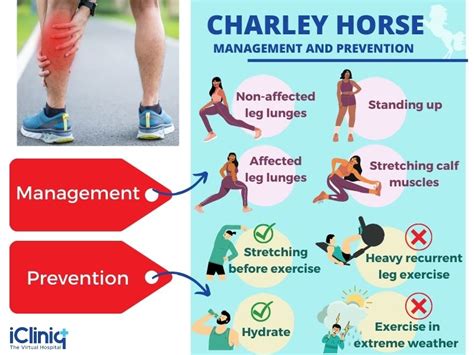Intro
Learn about Charley Horse during pregnancy, including causes, symptoms, and relief methods, to manage leg cramps and muscle spasms safely and effectively.
Pregnancy is a time of significant physical and emotional change for women. As the body adapts to support the growing fetus, various symptoms can arise, some of which may be unexpected or unfamiliar. One such symptom is the Charley horse, a condition characterized by sudden, intense muscle cramps, typically in the legs. Understanding the causes, symptoms, and management strategies for Charley horse during pregnancy is essential for expectant mothers to navigate this period comfortably.
The occurrence of Charley horse during pregnancy can be alarming, especially for those who have not experienced it before. It is crucial to recognize that while these muscle cramps can be painful and disruptive, they are generally not a cause for concern. However, understanding the underlying factors that contribute to their development can help pregnant women take preventive measures and manage their symptoms effectively. Lifestyle adjustments, dietary changes, and simple exercises can make a significant difference in reducing the frequency and severity of Charley horse episodes.
As the body undergoes numerous changes during pregnancy, it is essential to stay informed about potential symptoms and how to manage them. Charley horse, while not exclusive to pregnancy, can be more common during this period due to various physiological changes. By exploring the relationship between pregnancy and Charley horse, women can better prepare themselves for any challenges they might face, ensuring a healthier and more comfortable pregnancy journey.
Understanding Charley Horse

Charley horse, also known as muscle cramp, is a sudden, involuntary contraction of a muscle that can cause significant pain. During pregnancy, these cramps often occur in the legs, particularly in the calf, thigh, or foot. The exact cause of Charley horse is not always clear, but several factors can contribute to its development, including dehydration, mineral deficiencies (such as calcium, magnesium, or potassium), and muscle fatigue. In pregnant women, the expanding uterus can put pressure on nerves, leading to muscle cramps. Additionally, changes in blood circulation and the compression of nerves can also play a role.
Causes of Charley Horse During Pregnancy
Several factors can contribute to the development of Charley horse during pregnancy. These include:
- Mineral deficiencies: Pregnant women have a higher demand for minerals such as calcium, magnesium, and potassium. Deficiencies in these minerals can increase the risk of muscle cramps.
- Dehydration: Not drinking enough water can lead to dehydration, which is a common cause of muscle cramps.
- Pressure on nerves: As the uterus expands, it can put pressure on the nerves in the legs, leading to muscle cramps.
- Poor circulation: Changes in blood circulation during pregnancy can lead to a reduction in oxygen supply to the muscles, increasing the risk of cramps.
- Muscle fatigue: Increased weight and changes in posture during pregnancy can lead to muscle fatigue, making muscles more susceptible to cramping.
Managing Charley Horse During Pregnancy

Managing Charley horse during pregnancy involves a combination of preventive measures and strategies to alleviate symptoms when they occur. Here are some tips:
- Stay hydrated: Drinking plenty of water is essential to prevent dehydration, which can lead to muscle cramps.
- Maintain a balanced diet: Ensuring adequate intake of minerals such as calcium, magnesium, and potassium through diet or supplements (if recommended by a healthcare provider) can help prevent deficiencies.
- Stretch regularly: Gentle stretching exercises, especially before bedtime, can help reduce muscle cramps.
- Apply heat or cold: Applying a warm bath or a cold compress to the affected area can help relieve pain.
- Wear comfortable shoes: Avoiding high heels and wearing comfortable, supportive shoes can reduce muscle strain.
Preventive Measures
Prevention is key when it comes to managing Charley horse during pregnancy. Some preventive measures include:
- Regular exercise: Engaging in regular, gentle exercise can help improve circulation and reduce muscle fatigue.
- Avoiding strenuous activities: Avoiding activities that cause muscle strain can help reduce the risk of muscle cramps.
- Elevating the legs: Elevating the legs regularly, especially in the later stages of pregnancy, can help improve circulation and reduce swelling.
Treatment Options for Charley Horse

While most cases of Charley horse during pregnancy can be managed with self-care measures, there are instances where medical intervention may be necessary. If muscle cramps are severe, frequent, or persistent, it is essential to consult a healthcare provider. They can assess the situation and recommend appropriate treatment options, which may include:
- Medications: In some cases, medications such as magnesium or calcium supplements may be prescribed to help manage muscle cramps.
- Physical therapy: Gentle exercises and stretches recommended by a physical therapist can help improve muscle strength and flexibility.
- Alternative therapies: Some women find relief from muscle cramps through alternative therapies such as acupuncture or massage, though it's crucial to consult with a healthcare provider before starting any new therapies during pregnancy.
When to Seek Medical Attention
While Charley horse is generally not a cause for concern, there are situations where medical attention is necessary. These include:
- Severe pain: If the pain from muscle cramps is severe and does not improve with self-care measures.
- Frequent cramps: If muscle cramps occur frequently and interfere with daily activities.
- Other symptoms: If muscle cramps are accompanied by other symptoms such as swelling, redness, or warmth in the affected area.
Conclusion and Next Steps

In conclusion, while Charley horse during pregnancy can be uncomfortable and concerning, it is generally manageable with the right strategies and support. By understanding the causes, taking preventive measures, and knowing when to seek medical attention, pregnant women can navigate this symptom with confidence. It's also important to remember that each pregnancy is unique, and what works for one woman may not work for another. Therefore, staying in close communication with a healthcare provider and being open about any symptoms or concerns can ensure the best possible outcome for both mother and baby.
We invite you to share your experiences or ask questions about managing Charley horse during pregnancy in the comments below. Your insights can help others who may be going through similar challenges, and together, we can build a supportive community that prioritizes the health and well-being of expectant mothers.
What are the most common causes of Charley horse during pregnancy?
+The most common causes include mineral deficiencies, dehydration, pressure on nerves, poor circulation, and muscle fatigue. Ensuring adequate mineral intake, staying hydrated, and engaging in gentle exercises can help reduce the risk of muscle cramps.
How can I prevent Charley horse during pregnancy?
+Prevention involves staying hydrated, maintaining a balanced diet rich in minerals, stretching regularly, and avoiding strenuous activities. Elevating the legs and wearing comfortable shoes can also help improve circulation and reduce muscle strain.
When should I seek medical attention for Charley horse during pregnancy?
+It's essential to seek medical attention if the pain from muscle cramps is severe, if cramps occur frequently, or if they are accompanied by other symptoms such as swelling, redness, or warmth in the affected area. Consulting a healthcare provider can help determine the best course of action and rule out any underlying conditions that may need medical attention.
